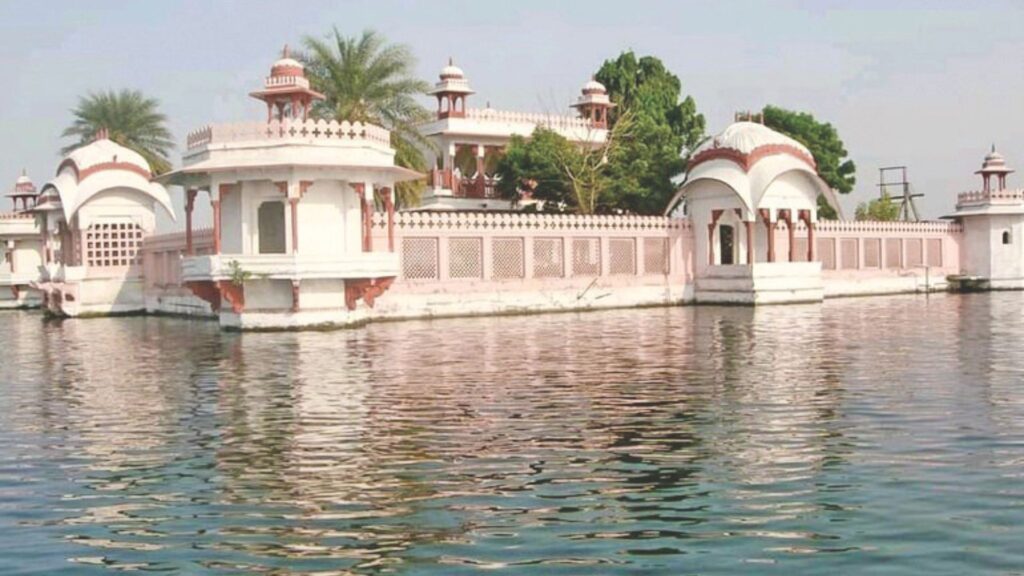The Kishore Sagar Jagmandir is an architectural beauty situated in Kota, Rajasthan. It has witnessed centuries of history and stands as a tribute to the artistic vision of Rajput rulers and their deep connection to water architecture.
A Royal Vision in Water and Stone
In 1346, the ambitious Bundi ruler Maharaja Deji constructed this ethereal palace island, not merely as a pleasure retreat but as a bold statement of architectural innovation. Rising from the artificial Kishore Sagar Lake, the Jagmandir showcases a harmonious blend of Rajput and Mughal architectural elements, creating a unique identity that sets it apart from other water palaces of Rajasthan.
The symmetrical structure, built entirely in white marble, features delicate chattris (dome-shaped pavilions), intricate jharokhas (overhanging enclosed balconies), and ornately carved pillars that reflect perfectly in the surrounding waters. This mirror image creates an illusion of a floating palace that appears to double in size during calm weather, earning it the local moniker “White Pearl of Kota.”
Engineering Marvel of the Medieval Era
What makes Kishore Sagar Jagmandir particularly fascinating is its advanced engineering for its time. The foundation of this water palace reveals sophisticated medieval construction techniques that have helped it withstand centuries of monsoons and changing water levels.
The palace stands on a carefully constructed artificial island, supported by a complex network of stone pillars driven deep into the lake bed. The builders employed an ingenious system of lime mortar mixed with unique organic materials, including jaggery, urad dal (black gram), and fruit pulp, creating a water-resistant barrier that continues to protect the structure today.
Gardens that Whisper Tales of Romance
The palace gardens, though modest in size, tell stories of royal romance and diplomatic encounters. Unlike the geometric precision of Mughal gardens, the Jagmandir’s green spaces follow a more organic design philosophy. Centuries-old champa trees (Plumeria) still bloom here, their sweet fragrance carried across the water just as it did when royal couples sought refuge in this serene retreat.
Historical records speak of secret midnight boat rides, where maharajas and their chosen companions would glide across the moonlit waters to reach this sanctuary. The garden’s original layout included clever acoustic features – strategic placement of walls and pillars that allowed whispered conversations to remain private despite the open setting.
Forgotten Chapters, The Palace as a Sanctuary
Lesser known historical accounts reveal that the Jagmandir served as more than just a pleasure palace. During times of political turmoil, it functioned as a secure haven for royal families. Its isolation in the middle of the lake made it an ideal refuge, with underwater passages (now sealed) providing emergency escape routes to the mainland.
During the 1857 uprising, the palace reportedly sheltered several British families, though this chapter remains contentiously debated among historians. The structure’s deep foundations hide chambers that were once used to store precious jewels and important documents, protecting them from both natural elements and human interference.

The Living Legacy of Craftsmanship
Walking through the palace today reveals an exceptional level of architectural detail that has survived centuries. The marble walls feature intricate jalework (perforated stone screens) that create mesmerizing patterns of light and shadow throughout the day. These designs weren’t merely decorative; they served as a sophisticated climate control system, allowing cool breezes to circulate while providing privacy to the occupants.
The palace’s pillars deserve special attention, each one uniquely carved with motifs that blend Hindu and Islamic artistic traditions. Local artisans speak of techniques passed down through generations, some still practicing the art of marble carving using tools similar to those employed by their ancestors who worked on the palace.
A Canvas for Changing Seasons
Kishore Sagar Jagmandir transforms dramatically with each season, offering visitors a different experience throughout the year. During monsoons, when the lake swells, the palace appears to rise from the waters like a lotus. The winter months bring migratory birds that use the palace’s numerous niches and cornices as temporary homes, creating a vibrant ecosystem.
The most spectacular transformation occurs during the annual Dussehra festival, when the entire structure is illuminated with thousands of traditional oil lamps. This centuries-old tradition continues today, though now supplemented with modern lighting that creates a magical reflection in the lake waters.
Cultural Heartbeat of Modern Kota
Today, Kishore Sagar Jagmandir serves as more than a historical monument; it’s the cultural pulse of Kota. The palace hosts classical music concerts, where the natural acoustics of its architecture enhance performances. Local artists gather here to paint, finding inspiration in the changing light and reflections that play across its white marble surfaces.
The monument has also become an important center for educational programs, where schoolchildren learn about architectural heritage and water conservation. The palace’s story of sustainable water architecture offers valuable lessons for modern urban planning.
The Folk Tales of Jagmandir
The white palace floating on Kishore Sagar has inspired countless local legends over the centuries. One particularly enchanting tale speaks of a mysterious musical phenomenon: on full moon nights, when the water is perfectly still, locals claim to hear the faint strains of classical music emanating from the palace’s central chamber. Historians attribute this to the structure’s remarkable acoustic design, where certain wind conditions create natural musical notes as air flows through the intricately carved jalis.
Another fascinating legend revolves around the palace’s construction. According to local storytellers, the chief architect was challenged to create a structure that would never sink, despite being built on water. The architect supposedly spent years studying water birds, particularly swans, to understand how they maintained perfect buoyancy. This observation allegedly influenced the unique base design of the palace, though modern engineers attribute its stability to the ingenious weight distribution system and the deep foundation pillars.
Traditional Water Management Wisdom
The Kishore Sagar Jagmandir complex incorporates sophisticated water management systems that deserve deeper examination. The lake itself features an intricate network of channels and control mechanisms that helped maintain optimal water levels throughout the year. These systems worked in harmony with seasonal rainfall patterns, demonstrating an advanced understanding of hydrology that predated modern engineering concepts.
The palace’s relationship with water extends beyond mere architecture. Historical records indicate that the structure played a crucial role in the region’s water conservation efforts. The lake’s design included natural filtration systems using specific types of stones and aquatic plants, some of which continue to help maintain water quality today.
Architectural Influence on Modern Design
Contemporary architects and urban planners increasingly look to Kishore Sagar Jagmandir for inspiration in sustainable building practices. The palace’s natural cooling systems, achieved through strategic placement of jalis and water channels, offer valuable insights for modern green architecture. Several recent buildings in Rajasthan have incorporated design elements inspired by the palace’s water-cooling techniques, adapting centuries-old wisdom to modern needs.
The monument continues to influence artistic expressions beyond architecture. Local textile designers have created collections featuring patterns inspired by the palace’s jali work, while contemporary photographers find endless inspiration in the play of light and shadow across its white marble surfaces throughout the day.
As Kishore Sagar Jagmandir stands gracefully on its watery foundation, it remains not just a testament to architectural brilliance but a living laboratory of sustainable design, cultural continuity, and artistic inspiration. In an age of rapid urban development and environmental challenges, this floating palace offers timeless lessons in harmony between human creation and natural elements.
Looking to the Future
As Kishore Sagar Jagmandir enters its eighth century, it stands as a bridge between Kota’s past and future. Plans are underway to develop the surrounding area as a cultural district, with the palace at its heart. However, the focus remains on maintaining the delicate balance between accessibility and preservation.
The palace continues to guard many secrets underwater chambers yet to be fully explored, hidden passages waiting to be discovered, and stories yet to be told. As modern technology allows for new methods of historical investigation, Kishore Sagar Jagmandir may reveal more chapters of its rich history to future generations.







